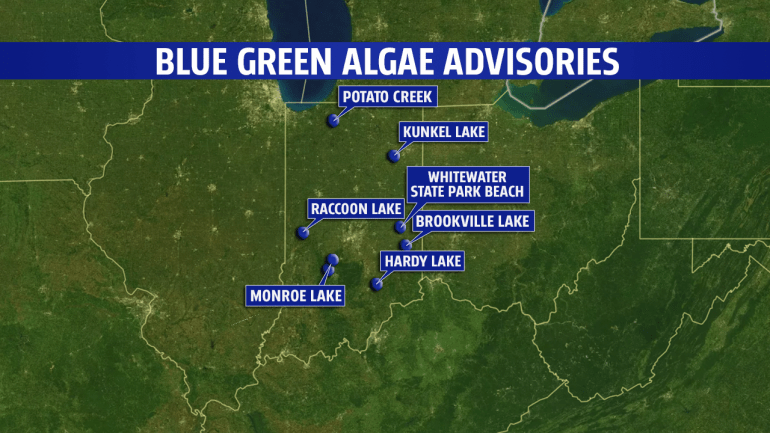BLOOMINGTON, Ind.– The state issued an advisory for several Indiana recreational spots that could have high amounts of blue-green algae.
The Indiana Department of Environmental Management issued the recreational advisory Friday. Blue-green algae has been in the headlines this week after several dogs in the southeast part of the country died from being exposed to it.

The advisory includes the following areas, which showed high levels of blue-green algae:
- Brookville Lake – Quakertown SRA
- Brookville Lake – Mounds SRA
- Cecil M Harden Lake – Raccoon Lake SRA
- Hardy Lake – Hardy Lake SRA
- Kunkel Lake – Ouabache SP
- Monroe Lake – Fairfax SRA
- Monroe Lake – Paynetown SRA
- Whitewater Lake – Whitewater Memorial SP
- Worster Lake – Potato Creek SP
“You’re not supposed to drink the water, it says in this advisory,” said DNR Reservoir Specialist, Phil Brown. “But you’re not supposed to really drink the water directly from the lake any time.”
Anyone who does go in the water should shower off as soon as possible, Brown says.
The advisory also says you should avoid allowing your pets to drink or swim in lake water under the advisory.
“Algae blooms can be harmful to animals to drink the water, and we advise them that they shouldn’t allow them to do that,” Brown said.
Last week, a woman in North Carolina lost three dogs to algae poisoning after they went swimming in a pond. Brown says DNR has not received any reports of pet deaths in Indiana during this advisory.
According to the DNR’s website, Blue Green Algae are capable of producing several different toxins. The toxins can cause rashes, skin or eye irritation. It can also cause nausea, stomach aches and tingling in the fingers and toes.
Animals are not necessarily more vulnerable to the algae toxin effects, but they are more likely to drink larger amounts of lake water while playing.
“Symptoms may range from lethargy and loss of appetite to seizures, vomiting and convulsions. Consumption of large quantities of the toxins could potentially cause death,” according to the DNR website.
Dogs can also be susceptible to algae “scum” attaching to their fur after playing in the water. That scum can be swallowed during self-cleaning.
Algae blooms can be fueled by excess lawn fertilizers and runoff from pastures, feedlots, lawns and golf courses. They can also be fueled by drainage from sewage systems, as well as warm, sunny weather.
Brown says when the Blue Green Algae blooms, the algae come under stress and die off.
“When they have a die-off is when they release the toxin that can become harmful to humans and animals,” he said.
Brown also says people should not assume they are clear of the algae simply because they can’t see it. At current levels, the algae may not be apparent to the eye.
“When people think of really harmful algae, they think of a big bluish green mass on the water,” Brown said. “That’s not something you’re seeing on here. We have algae in the water, but you’re not seeing any green masses here along the lake.”
Sampling of the water began on May 13 to coincide with the opening of swimming beaches around the state. Testing will continue through Aug. 26. You can learn more about Blue Green Algae, and the DNR’s current list of advisories on their website.










